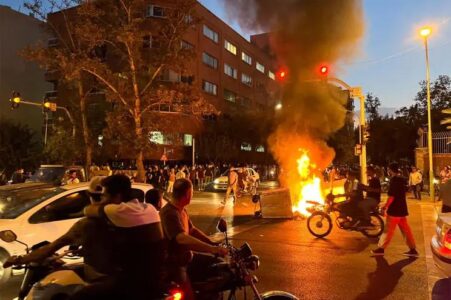
How Will the Situation in Tehran Unfold
As enraged people pour into the streets in most (if not all) Iranian cities, it is widely believed that this is the most dramatic development in the country in the last four decades. Yet, despite their gravity, these protests are not likely to bring down the current regime, unlike the 1979 protests that overthrew the Shah. After all, today’s regime is more violent. Yet, albeit still standing, and though still far from collapsing, it is crumbling piece by piece.
The resurgence of protests affirms that the state is in crisis and that anti-government protests are a chronic disease eating away at its weakening body. Not one year in the last two decades has gone by without people taking to the street to take a stand against their leadership. The faces changed: there was Khatami, then Ahmadinejad, then Rouhani, and now Raissi, but the people’s desire for change has not.
The root cause lies in the Iranian leadership’s inability to deal with the changing reality among its youth, threatening the regime’s sustainability. Indeed, ideological regimes rarely find it easy to backtrack on their rhetoric and methodologies. In Russia, for instance, the Communist Party embraced the revolution from within in 1991 when it stood on the brink of collapse.
For its part, China progressively shifted toward a more modern, flexible approach to administration, keeping the Communist Party but doing away with communist practices, be they uniform clothing, bicycles as the primary mode of transportation, or the hours-long daily preaches from the government about the virtues of communism and the evils of capitalism. The entire world changed its ways bar two countries: Iran and North Korea.
But Iran’s problem is domestic, and it will only grow if it insists on not admitting that both the problem and the solution lie within it. Instead of embracing change, and in its bid to evade responsibility, Tehran is resorting to the good old conspiracy narrative to explain current developments. It is pointing the finger at Americans, its neighbors, and the media. After all, its chain of Arabic-speaking media outlets whose sole occupation is to attack Iran’s rivals has never engendered a single protest in those rival countries.
The adage goes, “sow the wind, and reap the whirlwind.” It does not mean, though, that Iran can forever live in its glasshouse in a region that’s constantly on fire. The chaos we see in Iran today is simply the result of the confusion sown by Khamenei’s regime in the region.
Since their ascent to power, religious leaders in Iran have oppressively governed the lives of 70 million people, down to the smallest detail.
The recent unrest was ignited by the murder of a young Kurdish woman who was beaten to death by the morality police for wearing her hijab loosely. The murder enraged Iranians fed up with their regime’s failure to provide them with a decent life and its ongoing oppression of its people.
In a remarkable development, videos of the protests showed protesters attacking security forces in face-to-face confrontations. Another notable observation is that the regime resorted to isolating its people this time, shutting down the internet and social media access. However, it is unlikely that it will take any decisive measures to restore calm in the streets besides accusing the protesters of being ISIS militants or traitors.
Initially, President Ebrahim Raissi spoke to the crowds of protestors in an attempt to sway them, claiming that what the morality police did was a mistake and would be investigated and expressing his sympathies to the young woman’s family as if she were his daughter. Had the people taken to the streets solely to protest the crime, the regime might have succeeded in soothing their rage with promises of investigation and punishment for the perpetrators.
But the regime is facing an existential crisis, not simply a wave of protests against the cost of living or individual violations and practices. The theocratic regime is no longer tolerated or effective. Gone are the days of sanctifying the Supreme Leader and religious leaders. They have become symbols of corruption and autocracy in the eyes of the protesters. Today, Iran is a poor country boasting about military achievements that cannot possibly put food on the tables of its starving citizens.
The current unrest is the latest in a chain of protests that started in 2009 in universities and mushroomed into widespread protests across the capital, led then by religious figures rebelling against their leadership. Then in 2017, they resurfaced, protesting living conditions, and then in 2019, when they lasted several months across the countryside and remote governorates. The current uprising began in Kurdistan and quickly made its way to Tehran. Protests are here to stay and will eventually exhaust the regime, forcing it to make the concessions it refuses to make today.
Source: Aawsat





